- Visibility 191 Views
- Downloads 23 Downloads
- Permissions
- DOI 10.18231/j.ijced.2020.003
-
CrossMark
- Citation
A study on the presenting features observed in 100 patients of atopic dermatitis in a tertiary care hospital in North-Eastern India
- Author Details:
-
Bhawna Lochav
-
Bhaskar Gupta *
Abstract
Introduction: Atopic dermatitis is a relatively common age-related disease. Its pathophysiology is majorly insubstantial. Also, it appears as a result of interplay of maternal and inheritance, intrauterine and environmental factors. Also, immune dysregulation has an important role.
Objectives: To study the presenting features of atopic dermatitis.
Materials and Methods: 100 patients of atopic dermatitis which were diagnosed on the basis of modified UK working party criteria, after which clinical presentations were noted in a preset proforma.
Results: 78% were in the age group of 2-12 years, of which 65% were males and 35% were females.
Conclusion: Atopic dermatitis is a distinct, overt, age and IgE-related entity frequently showing different demographic and clinical presentations.
Introduction
Atopic dermatitis (AD)[1] is a non-contagious, very itchy, inflammatory, chronic skin condition which follows a course of exacerbations and remissions, usually occurs in infancy and childhood, has a positive family history and a history of atopy. It has a common association with an elevated immunoglobulin E (IgE) levels in serum. It has an immunological basis and also has a genetic/ familial predisposition and various environmental, life style and dietary factors. There is a constant increase in the prevalence of AD in developed nations and in countries which are presently in the phase of urbanization and industrialization. There is a complex interaction between susceptibility genes, environmental factors, skin barrier defect and systemic and local immunologic responses.[4], [3], [2] The Japanese scientist couple Teruka and Kimishige Ishizaka had discovered IgE in 1966 [5] which plays an important role in inducing an allergic response, and is mainly associated with type 1 hypersensitivity reaction. Its clinical presenation shows variation; hence, it is advisable to evaluate it periodically/seasonally.
Filaggrin insufficiency predisposes to barrier dysfunction but additionally Thelper 2 (Th2) cytokines (interleukin (IL)‐4 and IL‐13) can also down‐regulate filaggrin expression [42], indicating a complex interplay in which the epithelia and the immune system play a role in regulating each other.
Materials and Methods
Cross-sectional study of 40 AD patients was conducted in Silchar medical college, silchar over a period from July 2018 till June 2019. AD was diagnosed using modified UK working party criteria,[6] wherein presence of the major and at least three minor criteria were taken cognizance of.
Inclusion criteria
Patients fulfilling the modified UK working party criteria
Exclusion criteria
Patients not giving consent for history and examination.
Patients who received any form of treatment for atopic dermatitis.
Clinical history which included age, sex, occupation, residence, duration of disease, associated symptoms like itching seasonal fluctuation, associated conditions like asthma, allergic rhinitis, atopy, family history of AD, and asthma were noted in a preset proforma systemic and dermatological examination was done which also included examination of the mucous membranes and skin appendages. The findings which were obtained were noted and analysis done to study the clinical presentation of AD. Categorical variables obtained are represented using absolute numbers and percentages.
Prior ethical committee clearance was obtained.
Results
Sex and age distribution [Table 1] shows the sex and age distribution, 31 patients (78%%) were in the age group of 2-12 years, while only 10 (10%) were less than 2 years of age, and 12 (12%) were more than 12 years of age.
| Age (years) | Number | Percentage |
| <2years | 10 | 10% |
| 2-12 years | 78 | 78% |
| >12 years | 12 | 12% |
| Total | 100 | 100% |
Sex distribution
Atopic dermatitis is more common in males, seen in 65 patients (65%) out of 100. ([Table 2])
| Sex | Number | Percentage |
| Male | 65 | 65% |
| Female | 35 | 35% |
| Total | 100 | 100% |
Duration The duration of AD varied from 7 to 194 weeks. Its mean duration was 77 weeks with a standard deviation (SD) of 22.43 weeks [77 ± 22.43].
The frequency is as shown below-
| Presenting features | Frequency | Percentage |
| Xerosis | 80 | 80 |
| Hand and foot dermatitis | 80 | 80 |
| White dermographism | 78 | 78 |
| Food intolerance | 72 | 72 |
| Itch when sweating | 70 | 70 |
| Anterior neck folds | 68 | 68 |
| Intolerance to wool | 68 | 68 |
| Course influenced by emotional factors | 65 | 65 |
| Tendancy towards cutaneous infection | 65 | 65 |
| Cheilitis | 58 | 58 |
| Orbital darkening | 58 | 58 |
| Icthyosis/keratosis pilaris | 50 | 50 |
| Recurrent conjunctivitis | 25 | 25 |
| Nipple eczema | 20 | 20 |
| Pityriasis alba | 20 | 20 |
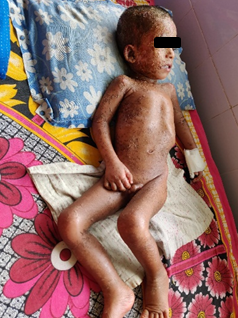
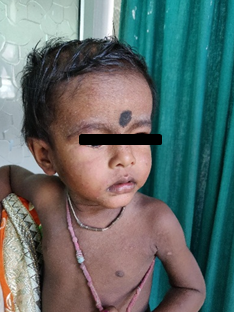
Winter exacerbation was a cardinal feature in 75(75%) followed by history of allergic rhinitis in 45(45%), asthma in 60(60%), and atopy per se in 35(35%), whereas a family of AD was present in 25(25%)patients.
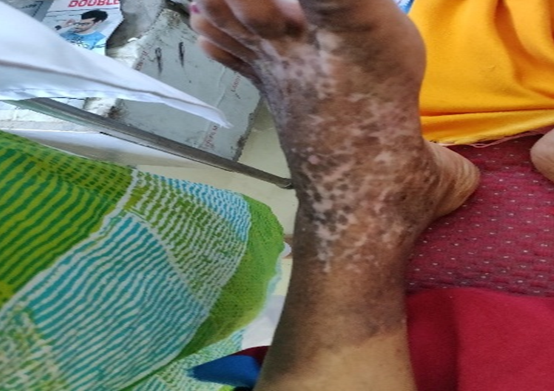
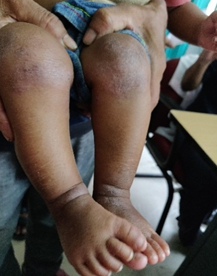
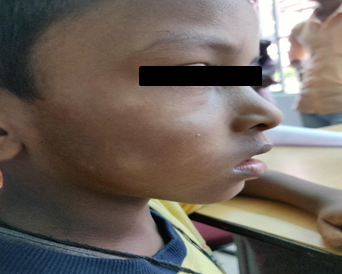
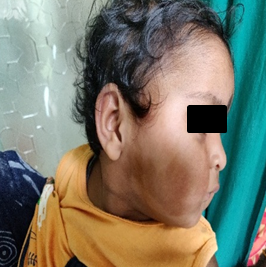
| Site of involvement | Number | Percentage |
| Extensors | 24 | 24% |
| Flexors | 52 | 52% |
| Face | 24 | 24% |
| Total | 100 | 100 |
Predominant areas/location of involvement of AD were noted. It was found that the flexures were majorly involved in 52(52%) patients, extensors involved in 24(24%) patients and involvement of the face was seen in 24(24%) patients of the study group.
Discussion
Atopic dermatitis, being a chronically relapsing and remitting inflammatory disease is difficult to treat. It is characterized by intense itching, erythematous, scaly and oozing papules and plaques. It is commonly associated with rising levels of IgE in serum. It was diagnosed by using the modified UK working party criteria in our study. It’s prevalence was calculated to be 0.25% in our study, whereas in a study conducted elsewhere in India [7] it was found to be 0.55%, this disease has a varying prevalence across the globe [8][9] ranging from 0.7% to 0.26%. The mean age at which AD has its onset was around 3.63 ± 1.42, having the shortest duration of 1 year and longest duration of 6 years, it is in correspondence with other studies [7][10] from the India, implying that it is disease of young children. The male to female ratio was 1.8:1 showing a clear preponderance of males over females, a finding which was similar to the study of Sarkar and Kanwar [11]., it was found to be 1.3:1 in another study.[7] Also, 70% of the patients belonged to urban setting, while others were from rural area (68%), a finding corresponding to an Indian study. [11] Duration of AD had a range of 7 to 194 weeks and a mean duration of 77 ± 22.43 weeks, these results were similar to those of Dhar and Kanwar [10] where the mean duration of disease at presentation was around 84 weeks. Also, a long term study showed the duration of the disease to be 288 weeks. [11]Itching was the main presenting feauture in our study, which is in corelation with other studies from India [11] and other parts of the globe. [12]Sarkar and Kanwar observed that winter exacerbation was a consistent feature in atopic dermatitis [11] and Rddzki et al. also observed similar finding[12] In a study done at Mayo clinic, 54% patients experienced winter exacerbation. [13] Dhar and Kanwar also noted winter aggravation. [12] In our study 45% of the patients showed history of associated asthma, 35% of the patients had history of associated atopy, and 45% showed history of allergic rhinitis. Hanifin and Rajka showed, [6] personal history of atopy was seen in 50% of patients with AD, while Roth and Kierland showed it to be present in 55% patients. [12] Rystedt et al.showed that 32% patients of AD had bronchial asthma and 60% suffered from allergic rhinitis. [11] Ellis et al.,[14] observed that in the most commonly occurring co-morbidities allergic rhinitis was seen in 7% patients with AD and asthma in 5% patients with AD.
Halbert et al.[15] noted that children with AD might have a significant personal history of atopy, ranging from 50% to 80%. Dhar and Kanwar [10] observed that in the childhood AD group, 15.35% had a personal history of atopy. It can be observed from the above-mentioned findings that children suffering from AD have a strong history of allergic rhinitis, asthma and atopy. Also 25% of the patients showed family history of AD. In a study by Hanifin and Rajka, it was 70% [6] 60% in a study by Roth and Kierlands, [13] Rystedt et al showed 51% and 45% in two different groups.[14] Dhar et al.[16] noticed that 40% patients had family history of atopy. In another study by Dhar et al.,[7] 65% showed family history of atopy.Minor criterion of Hanifin and Rajka [6] criteria majorly noted in our study were xerosis and hand/foot dermatitis, white dermatographism and Dennie-Morgan infraorbital fold; 72% of patients showed history of food intolerance; 70% patients complained of itching along with sweating; 68% had wool intolerance and 65% showed secondary infection and also its course was affected by emotional factors. Around 58% patients showed cheilitis and periorbital darkening; 50% had ichthyosis or keratosis pilaris; 25% had manifested recurrent conjunctivitis. Also 20% patients showed nipple eczema and pityriasis Alba. The overall clinical presentation was similar to those of earlier studies. [11][12] Also, 52% had involvement of flexures, 24% showed extensor involvement, whereas only 24% of the patients showed involvement of the face. Dhar et al showed similar observations. [7][11]
Source of funding
None.
Conflict of interest
None.
References
- Sehgal VN, Srivastava G, Dogra S. Atopic dermatitis: Current options and treatment plans. Skinmed. 2010;8:335-344. [Google Scholar]
- Staab D, Diepgen TL, Fartasch M, Kupfer J, Lob-Corzilius T, Ring J. Age-related structured educational programmes for the management of atopic dermatitis in children and adolescents: Multicentre, randomised controlled trial. BMJ. 2006;332:933-938. [Google Scholar]
- . Anonymous Atopic eczema-new insights in the definition, diagnostics and disease management. Acta Derm Venereol Suppl (Stockh). 2003;215:7-48. [Google Scholar]
- . Anonymous Consensus Conference Management of atopic dermatitis in children. Recommendations (short version). Eur J Dermatol. 2005;15:215-223. [Google Scholar]
- Ishizaka K, Ishizaka T, Hornbrook MM. Physicochemical properties of human reaginic antibody IV. J Immunol. 1997;1:75-85. [Google Scholar]
- Hanifin JM, Rajka G. Diagnostic features of atopic dermatitis. Acta Derm Venereol. 1980;92:44-47. [Google Scholar]
- Dhar S, Mandal B, Ghosh A. Epidemiology and clinical pattern of atopic dermatitis in 100 children seen in a city hospital. Indian J Dermatol. 2002;47:202-204. [Google Scholar]
- Dotterud LK, Kvammen B, Lund E, Falk ES. Prevalence and some clinical aspects of atopic dermatitis in the community of Sor-Varanger. Acta Derm Venereol. 1995;75:50-53. [Google Scholar]
- Williams H, Robertson C, Stewart A, Ait-Khaled N, Anabwani G, Anderson R. Worldwide variations in the prevalence of symptoms of atopic eczema in the International Study of Asthma and Allergies in Childhood. J Allergy Clin Immunol. 1999;103:125-163. [Google Scholar]
- Dhar S, Kanwar A. Epidemiology and clinical pattern of atopic dermatitis in a North Indian pediatric population.. Pediatr Dermatol. 1998;15(5):347-351. [Google Scholar]
- Sarkar R, Kanwar AJ. Clinico-epidemiological profile and factors affecting severity of atopic dermatitis in north Indian children. Indian J Dermatol. 2004;49:117-122. [Google Scholar]
- Roth HL, Kierland RR. The natural history of atopic dermatitis. A 20-year follow-up study. Arch Dermatol. 1964;89:209-223. [Google Scholar]
- Rystedt I. Prognostic factors in atopic dermatitis. Acta Derm Venereol. 1985;65:206-213. [Google Scholar]
- Ellis CN, Drake LA, Prendergast MM, Abramovits W, Boguniewicz M, Daniel C. Cost of atopic dermatitis and eczema in the United States. J Am Academy Dermatol. 2002;46(3):361-370. [Google Scholar]
- Halbert AR, Weston WL, Morelli JG. Atopic dermatitis: Is it an allergic disease? . J Am Acad Dermatol. 1995;33:1008-1018. [Google Scholar]
- SD, Kanwar A, Nagaraja. Personal and family history of atopy in children with atopic dermatitis in north India. Indian J Dermatol . 1997;42:9-13. [Google Scholar]
How to Cite This Article
Vancouver
Lochav B, Gupta B. A study on the presenting features observed in 100 patients of atopic dermatitis in a tertiary care hospital in North-Eastern India [Internet]. IP Indian J Clin Exp Dermatol. 2020 [cited 2025 Oct 08];6(1):10-14. Available from: https://doi.org/10.18231/j.ijced.2020.003
APA
Lochav, B., Gupta, B. (2020). A study on the presenting features observed in 100 patients of atopic dermatitis in a tertiary care hospital in North-Eastern India. IP Indian J Clin Exp Dermatol, 6(1), 10-14. https://doi.org/10.18231/j.ijced.2020.003
MLA
Lochav, Bhawna, Gupta, Bhaskar. "A study on the presenting features observed in 100 patients of atopic dermatitis in a tertiary care hospital in North-Eastern India." IP Indian J Clin Exp Dermatol, vol. 6, no. 1, 2020, pp. 10-14. https://doi.org/10.18231/j.ijced.2020.003
Chicago
Lochav, B., Gupta, B.. "A study on the presenting features observed in 100 patients of atopic dermatitis in a tertiary care hospital in North-Eastern India." IP Indian J Clin Exp Dermatol 6, no. 1 (2020): 10-14. https://doi.org/10.18231/j.ijced.2020.003
